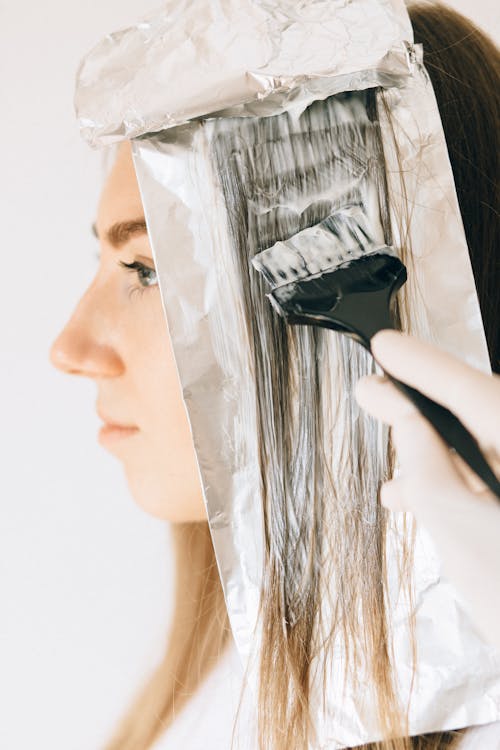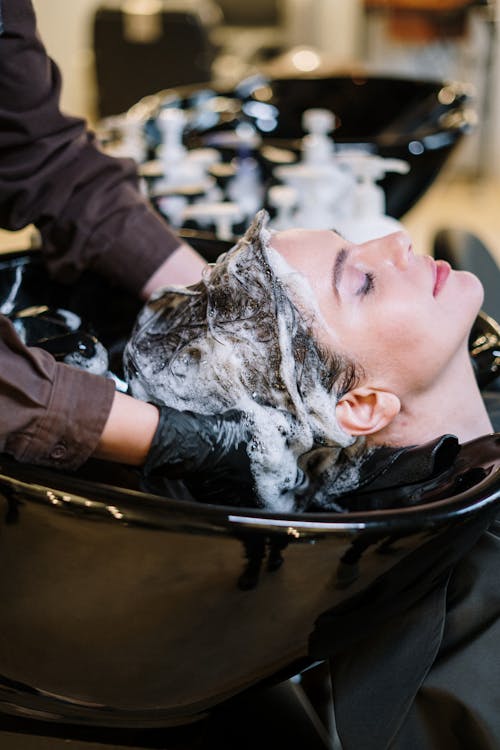Flaky to Fabulous: Understanding and Tackling Dandruff Head-On
Welcome to our blog post, where we embark on a journey to explore a topic that affects countless individuals: dandruff. Whether you've experienced it firsthand or are seeking insights to help a loved one, this blog post will unravel the mysteries of dandruff and equip you with valuable knowledge to combat it effectively. From understanding its causes and symptoms to discovering tried-and-true remedies and preventative measures, we're here to guide you on a path toward a healthier, flake-free scalp. So, let's dive in and discover the secrets to banishing dandruff once and for all.
Shedding Light on Dandruff
Picture this: you're getting ready for a special occasion, eagerly trying on different outfits when suddenly you notice a dusting of tiny white flakes on your shoulder. Cue disappointment and self-consciousness. Dandruff, a common scalp condition, affects millions of people worldwide. It manifests as white or grayish flakes of dead skin that accumulate on the scalp and become visible on hair and clothing. But what exactly causes this phenomenon?
The Culprits Behind Dandruff
Dandruff is a common condition that affects the scalp, causing flaking and itching. While the exact factor that causes dandruff is not fully recognized, there are different aspects that help in its development. Here are some of the culprits behind dandruff:
1. Malassezia Fungus: Malassezia is a type of fungus that is naturally present on the scalp of most individuals. However, in some people, it can overgrow, leading to scalp irritation and increased cell turnover, resulting in dandruff.
2. Seborrheic Dermatitis: Seborrheic dermatitis is a chronic inflammatory condition that affects areas rich in sebaceous glands, such as the scalp. It is characterized by red, itchy, and flaky skin, including dandruff. The exact cause of seborrheic dermatitis is unknown, but it is believed to involve a combination of genetic, hormonal, and environmental factors.
3. Sensitivity or Allergic Reactions: Some individuals may be sensitive to certain hair care products, including shampoos, conditioners, or hair dyes. These products can cause scalp irritation, leading to dandruff-like symptoms. There are also certain ingredients in hair products that can cause allergic reactions leading to trigger dandruff.
4. Dry Skin: Dry skin is a common cause of dandruff. When the scalp lacks moisture, it can become dry, itchy, and prone to flaking. Cold weather, low humidity, and excessive use of harsh hair products can contribute to dry skin on the scalp.
5. Poor hygiene: Inadequate scalp hygiene, such as infrequent shampooing or improper cleansing, can contribute to the accumulation of dead skin cells, oils, and product residue on the scalp. This buildup can lead to dandruff.
6. Diet and lifestyle: Although the link is not well-established, some studies suggest that diet and lifestyle factors may influence the development or severity of dandruff. For example, a diet lacking in certain nutrients, such as zinc, vitamin B, and omega-3 fatty acids, may contribute to dandruff. Stress and other lifestyle factors can also potentially worsen symptoms.
It's important to note that dandruff can vary from person to person, and the exact cause may differ. If you're experiencing persistent or severe dandruff, it's best to consult a dermatologist or healthcare professional for a proper diagnosis and appropriate treatment.
Unraveling the Symptoms
- Flaky scalp
- Itching
- Scalp redness
- Dryness
- Oily scalp
- Scalp tenderness
It's important to remember that dandruff symptoms can vary in intensity and may come and go over time. If you're experiencing persistent or severe symptoms, it is recommended to seek medical advice for an accurate diagnosis and appropriate treatment.
Combating Dandruff with a Multi-Faceted Approach
To combat dandruff effectively, it's often necessary to adopt a multi-faceted approach that addresses the underlying causes and relieves symptoms. Here are several strategies you can consider:
1. Regular and Gentle Cleansing: Wash your hair regularly with a mild shampoo specifically formulated for dandruff. Gently massage the scalp to remove any excess oil, dead skin cells, and product buildup. Avoid using hot water as it can strip the scalp of natural oils, contributing to dryness.
2. Anti-dandruff Shampoos: Look for shampoos containing active ingredients such as pyrithione zinc, ketoconazole, selenium sulfide, or coal tar. These ingredients help control the growth of the Malassezia fungus and reduce scalp inflammation. Use these shampoos as directed by the manufacturer or your healthcare professional.
3. Moisturize the Scalp: If you have a dry scalp, use a gentle conditioner or moisturizing treatment after shampooing. These products can help restore moisture and prevent dryness and flaking.
4. Balanced Diet and Hydration: Maintain a healthy diet rich in essential nutrients, including omega-3 fatty acids, zinc, and B vitamins, as they promote scalp health. Drink an adequate amount of water to keep your body hydrated throughout the day.
5. Stress Management: Stress can exacerbate dandruff symptoms. Incorporate stress management techniques such as exercise, meditation, and relaxation exercises into your routine to help reduce stress levels.
6. Avoid Scratching: While it may be tempting to scratch an itchy scalp, try to resist the urge. Scratching can further irritate the scalp, leading to inflammation and worsening of dandruff. You can gently massage the scalp with your fingertips to relieve itching.
7. Avoid Harsh Hair Products: Some hair care products, such as styling gels, mousses, and hair sprays, can worsen dandruff. Opt for mild, fragrance-free, and hypoallergenic hair products. Avoid excessive hair styling products and minimize heat styling, as they can contribute to scalp dryness.
8. Seek Medical Advice: If over-the-counter dandruff treatments and home remedies do not provide sufficient relief, or if your symptoms persist or worsen, consult a dermatologist or healthcare professional. They can evaluate your condition, provide a proper diagnosis, and recommend prescription-strength treatments if necessary.
Remember, consistent and diligent care is key to managing dandruff effectively. As it may take time to spot any improvements, so be patient.
DIY Masks for Dandruff
Here are three DIY hair masks that you can try at home to help alleviate dandruff:
1. Coconut Oil & Tea Tree Oil Hair Mask:
- Ingredients:
- 2 tablespoons of coconut oil
- Tea tree oil (4-5 drops)
- Instructions:
1. In a small bowl, mix the coconut oil and tea tree oil together.
2. Apply the mixture directly to your scalp, focusing on the areas affected by dandruff.
3. Gently massage the mask into your scalp for a few minutes to promote circulation.
4. Leave the hair mask on for at least 30 minutes to an hour.
5. Rinse thoroughly and shampoo your hair as usual.
Tea tree oil has antimicrobial properties that can help combat the fungal overgrowth associated with dandruff, while coconut oil helps moisturize the scalp and reduce dryness.
2. Apple Cider Vinegar and Yogurt Mask:
- Ingredients:
- two tablespoons of apple cider vinegar
- 1/2 cup of plain yogurt (unsweetened)
- Instructions:
1. In a bowl, mix the apple cider vinegar and yogurt until well combined.
2. Apply the mixture to your scalp, massaging it gently.
3. Leave the hair mask on for at least 30 minutes.
4. Rinse thoroughly and shampoo your hair afterward.
Apple cider vinegar helps balance the pH of the scalp and has antimicrobial properties. Yogurt contains probiotics that can help restore the natural balance of the scalp and reduce inflammation.
3. Aloe Vera and Lemon Juice Mask:
- Ingredients:
- two tablespoons of fresh gel of aloe vera
- one tablespoon of squeezed lemon juice (preferably fresh)
- Instructions:
1. Mix the aloe vera gel and lemon juice in a bowl.
2. Apply the mixture to your scalp, focusing on the areas affected by dandruff.
3. Leave the hair mask on for about 30 minutes.
4. Rinse thoroughly and shampoo your hair as usual.
Aloe vera has soothing and anti-inflammatory properties that can help reduce scalp irritation and itching. Lemon juice acts as a natural exfoliant and can help remove dead skin cells from the scalp.
It's important to note that these DIY hair masks may not work for everyone, and individual results may vary. If you have any known allergies or sensitivities to the ingredients mentioned, it's best to perform a patch test before applying the mask to your entire scalp. Additionally, if your dandruff persists or worsens, it's advisable to consult a dermatologist for a proper diagnosis and personalized treatment plan.
Beyond Dandruff: Nurturing a Healthy Scalp
As we conclude this blog post, it's crucial to emphasize the importance of overall scalp health. While dandruff may be a temporary concern, maintaining a healthy scalp is a long-term goal. We've discussed practices that promote a balanced scalp environment, such as regular cleansing, moisturizing, and protecting your scalp from harsh environmental factors. By implementing these habits, you can reduce the chances of dandruff recurrence and embrace healthier, more lustrous hair.
However, it's important to understand that dandruff can have various causes, and what works for one person may not work for another. If your dandruff persists or worsens despite trying home remedies, it's recommended to seek professional advice from a dermatologist or healthcare professional. They can evaluate your condition, provide an accurate diagnosis, and suggest appropriate treatments tailored to your specific needs.
By taking a proactive and comprehensive approach to managing dandruff, you can improve scalp health and reduce the discomfort associated with dandruff flakes and itching, leading to healthier, flake-free hair.







Comments
Post a Comment